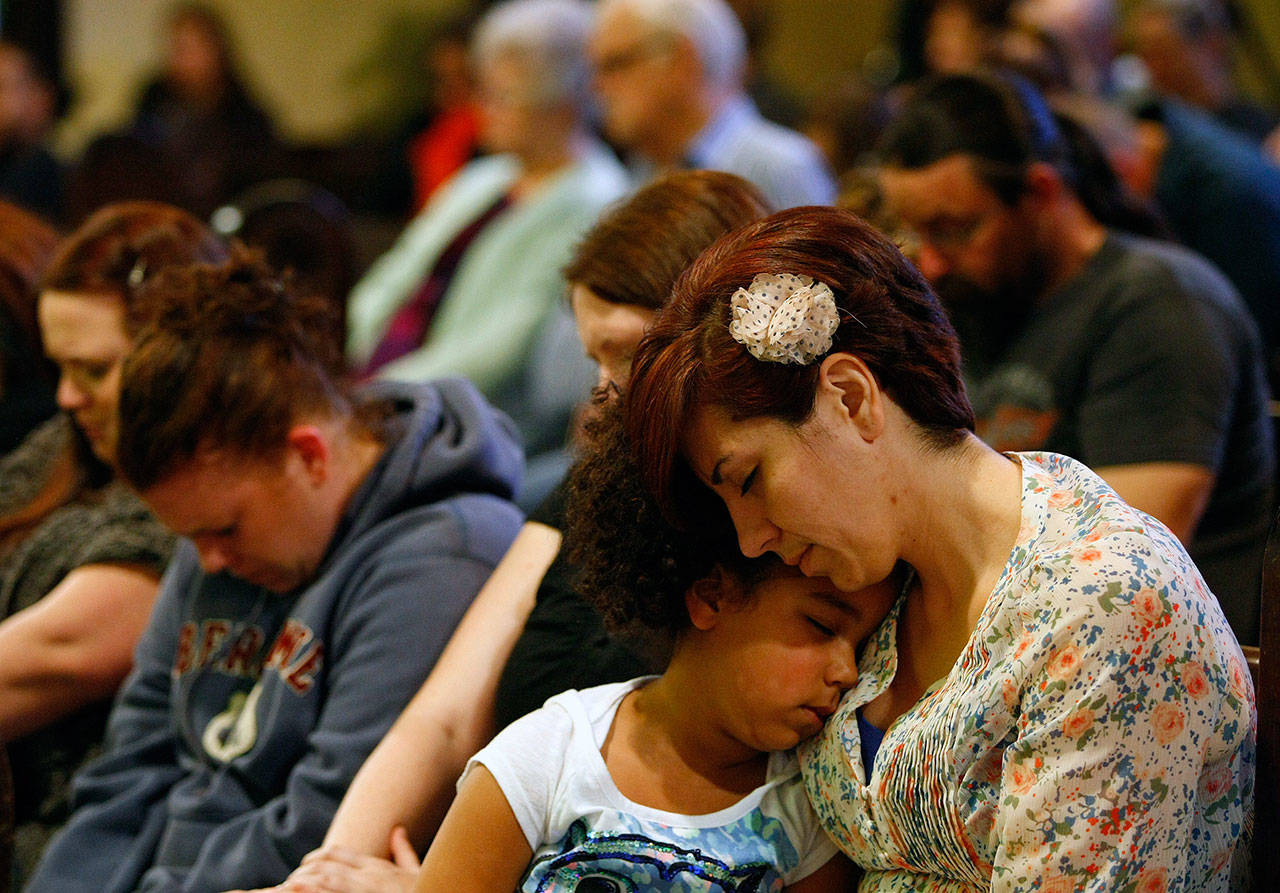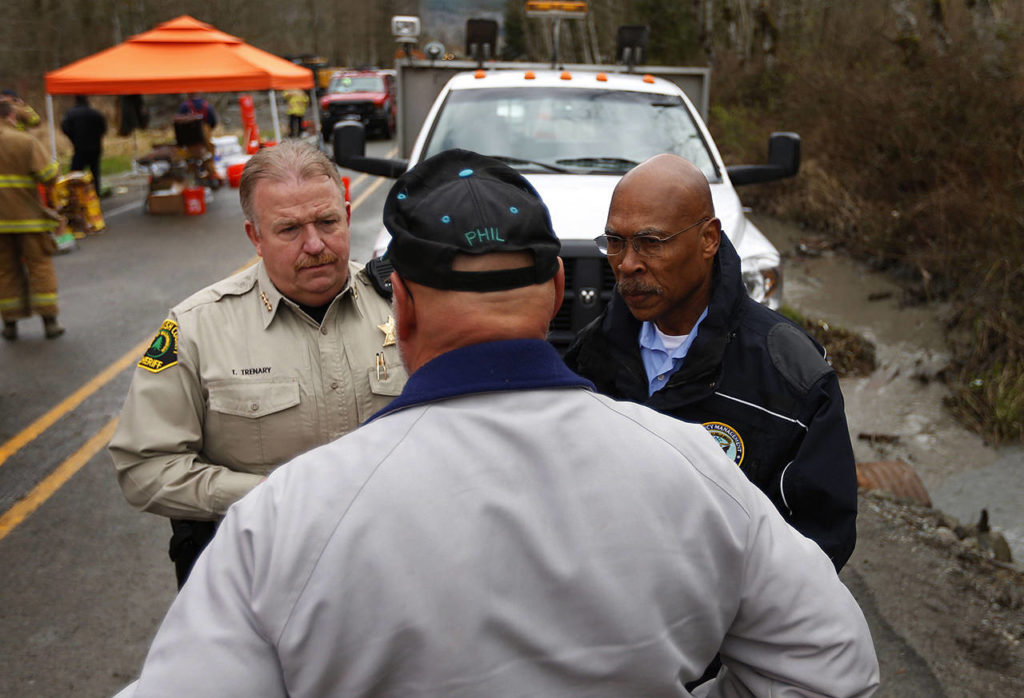Editor’s note: “The Rising” was published on May 30, 2014, just 69 days after a devastating mudslide near Oso, Washington, wiped out a rural neighborhood and killed 43 people. This is the original text and reflects the information that was available at the time.
As he helped to coordinate the community’s response to the March 22 mudslide, Snohomish County Executive John Lovick experienced what he came to call “Oso moments,” when the things he had seen or heard simply became too much.
The worst may have come April 6, when he was touring the site with Jeh Johnson, secretary of Homeland Security.
“Where are the homes?” Johnson asked.
“Sir, they are all gone,” Lovick said.
“And to have him look out there and to see the look on his face, that everything was gone, that was a terrible Oso moment,” Lovick said.
There have been great moments, too, most brought by others’ acts of kindness.
One arrived as a letter from a middle-school student in Brodhead, Wisconsin.
“Hi, I’m Derrick,” the boy wrote. “I am not good at writing letters, so I will say I care for you and wish you love and hope.”
“And Derrick attached a $5 bill to it,” Lovick said. “And when you have things like that happen, and you see all of the tremendous things that people are doing in this community, it brings those Oso moments. It tells me, there are disasters, and disasters do happen. It’s how we respond to them.”
Snohomish County Sheriff Ty Trenary was stunned when he drove up Highway 530 that first day and saw the damage.
“I’ve been on that road many, many times, and pulling up to it for the very first time was horrific. And I found myself not able to really comprehend what I was seeing. You’ve all seen the photographs … but to be out there and to see it and smell it and hear it was horrible.”
Then he saw how people in the Stillaguamish Valley reacted. They insisted on helping, and they ignored anyone who got in the way.
“And thank God they did,” Trenary said. “As I look back on this whole event, I think we’re changed in how we see community involvement in a natural disaster. The mentality that first responders show up and do the job has been replaced by, ‘No, it is a community event. Everybody jumps in.’ You deal with those decisions afterwards, but you don’t worry about whether somebody’s got a uniform on or not; you take the help and you go forward.”
Lorraine Nations is a medical assistant at Cascade Valley Hospital.
Her son, Quinn Nations, was among those who fought through the mud, helping to save at least two lives that day. He then spent weeks working to recover those who didn’t survive.
“I’m sorry if I’m bragging, but it makes my heart swell to know that I raised someone that was so able to help people and didn’t give it a second thought to go in and just start doing naturally what he was taught to do,” she said.
“I can’t say how proud I am of not only my son, but everyone up there on the Darrington side as well as the Oso side,” she said. “The volunteers, the stories, are unbelievable how people are coming together to help. I am so proud to be able to say I am from there.”
Marc Ford of Darrington was among the first to race to the aid of people caught in the slide. He spent weeks working on the team that searched the debris for victims.
His best Oso moment came that first evening, when his friends, the Kuntz family, showed up at his home. They were out of town when the slide hit. Their home was destroyed, but they were alive.
“The worst moment was Tuesday (April 22) when they completely pulled us off the job with two more people to find. That was the worst,” he said.
Oso Fire Chief Willy Harper said one of his strongest Oso moments came when searchers found the body of one of his friends.
Every machine shut down. Everybody working removed their hats and stood in silence. The display of respect was deeply moving.
“And to be able to witness that, to be there at that exact time, was probably the best and worst” moment, he said.
At Cascade Valley Hospital in Arlington, Dr. Paul Naumann performed emergency surgery on a woman who was rescued from the pile.
As he worked, he was buoyed by news that the woman’s baby was at Harborview Medical Center in Seattle.
The woman, Amanda Skorjanc, and 5-month-old Duke both survived.
The hospital was expecting up to 50 patients from the slide that day.
“Unfortunately, when the sun went down, the patients quit coming and the radios all kind of went silent. We knew what that had meant, that patients could no longer be searched for, that they weren’t finding victims.”
• • •
David Scott grew up in Stanwood. He’s now a crew chief and petty officer second class on a U.S. Navy search-and-rescue helicopter based at Whidbey Island Naval Air Station. The Navy aircraft was the third rescue helicopter on the scene March 22, and the crew played a key role in saving slide victims. It hurt to learn a few days later that one of the men they’d tried to help did not survive.
“I feel like I’ve gained perspective on community and personal loss,” he said. “A lot of the time in the Navy when we deal with disaster response and other rescue scenarios or operations, it’s in another part of the world, it’s in another region, another state. This one hits much closer to home.”
Sean Wright of Darrington ignored orders March 22 and waded into the debris field to search for survivors. His best moment came when he finally stopped and realized that he’d helped four people. Three lived.
“Seeing it, looking at it, you would never think that anything would survive through something like that.”
His worst moment came the next morning, when he returned to the debris field and found it empty of emergency crews.
It was hard to see, “because this is a town of doers.”
Barbara Hinshaw, a nurse at Arlington’s Cascade Valley Hospital since 1974, managed the emergency room when the mudslide hit.
Her darkest moments that day came when she saw the shock on medics’ faces as they brought in victims, and when she learned that the father of one of her young patients had died at another hospital.
“The best thing that came out of this is I just am so proud of my staff, the hospital and the community for how they pulled together to make everything work as smoothly as it possibly could and to support the victims, the families and the rescuers that were all impacted by the slide,” she said.
Toby Hyde, assistant Oso fire chief, spent hours helping people evacuate from areas that could have flooded if the debris dam blocking the river had burst.
“I think that first night was the worst time, knowing that people’s lives had changed in an instant … and not fully grasping what that was about.”
Talk to us
> Give us your news tips.
> Send us a letter to the editor.
> More Herald contact information.



























